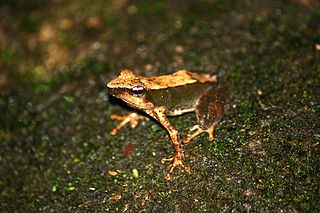
Micrixalus is a genus of frogs from that are endemic to the Western Ghats in India. They are monotypic within the family Micrixalidae. Before being raised to the family level they were classified as the subfamily Micrixalinae within Ranidae. Micrixalus frogs, such as Micrixalus saxicola, are popularly known as "dancing frogs" due to their peculiar habit of waving their feet to attract females during the breeding season. Dancing frogs are extremely vulnerable as their habitat is severely threatened.

Micrixalus fuscus is a species of small frog found in dense forested hill streams in the Western Ghats of India. M. herrei was formerly synonymized within this species.

Micrixalus saxicola is a species of frog in the family Micrixalidae, found in forest streams in the Western Ghats of India.This frog has a brown colored dorsum and a white ventral side with irregular white specks on its dark brown throat and chest. Its smooth skin and cryptic coloration allow it to blend into its surroundings while resting or calling. The males of the species are territorial, and will use calling, foot tapping, and foot flagging to warn off competition. M. saxicolais is described by the IUCN as a vulnerable species due to habitat loss, fragmentation, and human interference.The frog also threatened by infection by the fungus Batrachochytrium dendrobatidis.
Dischidodactylus duidensis is a species of frog in the family Craugastoridae. It is endemic to Venezuela and only known from its type locality, Cerro Duida. It was formally described in 1968 by Juan A. Rivero, even though the type series was collected 40 years earlier by George Henry Hamilton Tate.

Micrixalus elegans is a species of frog in the family Micrixalidae. It is endemic to the Western Ghats, India, and occurs between the Palakkad Gap and Goa Gap in the states of Kerala and Karnataka. Micrixalus elegans is one of the Micrixalus species showing "foot-flagging" behaviour, hence the common name elegant dancing frog has been proposed. Other common names include elegant torrent frog and elegant bush frog.

Micrixalus kottigeharensis is a species of frog in the family Micrixalidae. It is endemic to the Western Ghats in Karnataka, India. It is one of the "Top 100 Evolutionarily Distinct and Globally Endangered (EDGE) Amphibians". The specific name means "from Kottigehara".
Minervarya charlesdarwini is a species of frogs in the family Dicroglossidae. It is endemic to the Andaman Islands, India, and is known from the South Andaman Island, Long Island, and North Andaman Island.

Micrixalus adonis is a newly described species of frogs in the family Micrixalidae. It is endemic to the Western Ghats in southern India, restricted to areas between the Palghat Gap and Shencottah Gap. Common name beautiful dancing frog has been proposed for this species, in reference to its vividly rich colouration.

Micrixalus frigidus is a species of frogs in the family Micrixalidae. It is endemic to the Western Ghats, India. Its natural habitats are subtropical or tropical moist lowland forest and rivers.

Micrixalus herrei is a newly redescribed species of frog in the family Micrixalidae. Originally described in 1942, it was synonymized with M. fuscus in 1984. However, morphological differences as well as DNA evidence confirm this species to be valid. It is endemic to the Western Ghats, India, and occurs south of the Shencottah Gap in Kerala and Tamil Nadu states. The common name Kallar dancing frog has been proposed for this species, in reference to Kallar, Trivandrum, its type locality.

Micrixalus kurichiyari is a species of frogs in the family Micrixalidae. It is endemic to the Western Ghats, India, and only known from its type locality, Kurichiyarmala in the Wayanad District, Kerala state. Common name Kurichiyar dancing frog has been coined for it, in reference to the type locality.

Micrixalus mallani is a species of frogs in the family Micrixalidae. It is endemic to the Western Ghats, India.

Micrixalus nelliyampathi is a newly described species of frog in the family Micrixalidae. It is endemic to the Western Ghats, India.

Micrixalus niluvasei is a newly described species of frogs in the family Micrixalidae. It is endemic to the Western Ghats, India.
Micrixalus nigraventris is a species of frogs in the family Micrixalidae. It is endemic to the Western Ghats, India.

Micrixalus sali, commonly known as Sali's Dancing Frog, is a species of frogs in the family Micrixalidae. It is endemic to the Western Ghats, India. The preferred habitats of M. sali are damp leaf litter, exposed streambeds, and brooks in moist evergreen forests.

Micrixalus specca is a species of frogs in the family Micrixalidae. It is endemic to the Western Ghats, India.
Micrixalus spelunca is a species of frogs in the family Micrixalidae. It is endemic to the Western Ghats, India.

Micrixalus uttaraghati is a species of frogs in the family Micrixalidae. It is endemic to the Western Ghats, India.

Indosylvirana indica, the Indian golden-backed frog, is a species of frog in the family Ranidae. It was formerly considered as conspecific with Indosylvirana temporalis but was found to be a distinct species in a 2014 study.















